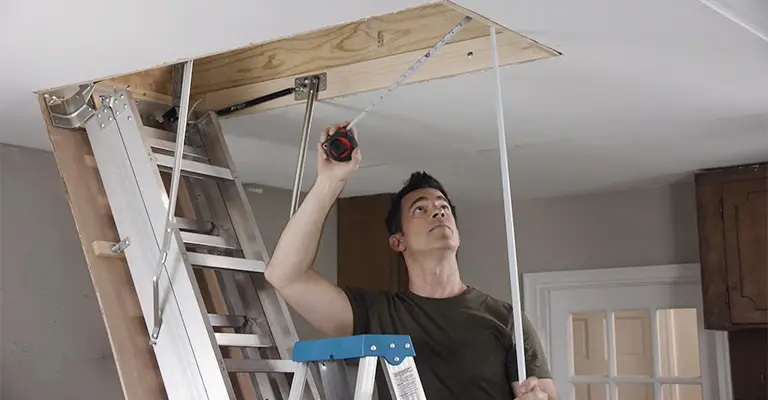Concealing an attic access door in your ceiling not only enhances the aesthetics of your living space but also adds an element of mystery to your home.
If you’ve ever found yourself wondering how to seamlessly integrate this functional yet often unsightly entryway into your decor, you’ve come to the right place.
To hide an attic door in a ceiling, the most straightforward method is to place a large armoire or bookcase in front of it. As a result, your door will be effectively hidden, leaving your home looking more polished and finished.
A false ceiling can also be installed over the attic door. Besides hiding the door, this will help insulate your home and reduce noise.
Whether you’re looking to blend it discreetly into the surroundings or turn it into a captivating design feature, we’ve got you covered.
In this guide, we’ll explore clever and creative ways to hide a ceiling attic door without compromising on accessibility or convenience.
Different Ways To Hide Attic Door In Ceiling
We’re going to show you how you can hide an attic door in your ceiling in a few different ways! Read on for tips on how to camouflage your attic door.
The goal is to blend the door into the surroundings to make it less noticeable. In the following section, we’ll look at several ways to hide your attic door and when they might be useful.
1. Remove The Lock And Handle From The Attic Door
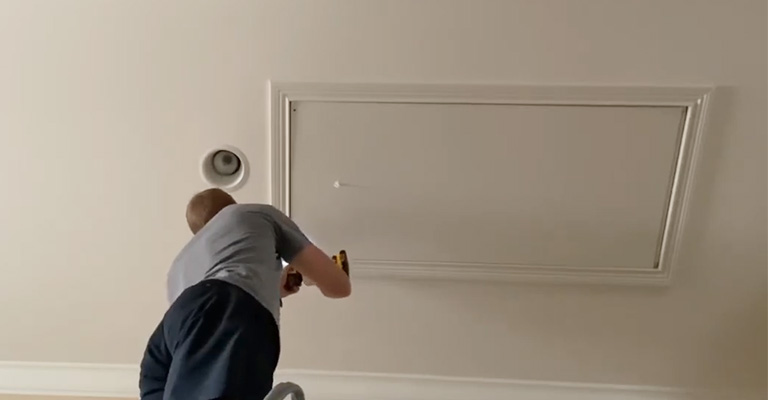
You may want to remove the lock and handle of your attic door if you want to hide it as much as possible. The handle and lock can be removed by unscrewing the screws.
The door can be painted to match the surrounding area once you remove the lock and handle. It will almost be impossible to see the door this way.
There is no point in using this technique if you have to lock the door. It will be necessary to find another way to hide the door if you need to lock it.
When you don’t need to lock the door, then this is a great way to virtually disappear it.
2. Lighten Up
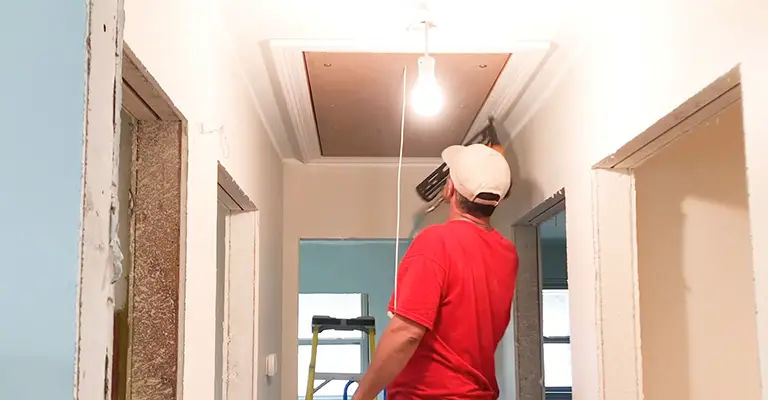
Suppose you want to hide your attic door more permanently. Adding a couple of lighting fixtures may be a good idea in that case.
Adding a light fixture either side of the door will do the trick. It will also serve as a way to bring some extra light into the room as well as conceal the door.
In case your hallway is dark or if you just want to make your home look more inviting, this is the perfect option for you. Let’s say you have no idea how to add lights.
An electrician or architect may be able to provide you with assurances that the wiring will be safe if you open the attic door. It’s definitely worth considering if you’re serious about this design idea!
3. Remove The Pull Cord From That Door
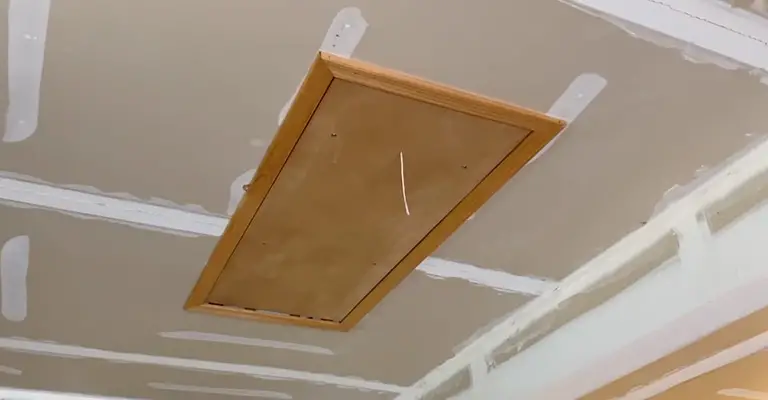
An attic door often has a pull cord hanging from the ceiling. The cord allows access to the attic and opens the door. This cord is unattractive and may even be a problem.
A pull cord can be removed from an attic door to conceal it. A handle or latch can be installed on the inside of the door to accomplish this.
This way, you won’t have to worry about the cord getting in the way when opening the door. You can paint the handle to match the ceiling once you’ve replaced the cord with a handle.
Simply display a few artfully placed photographs, and your guests won’t even realize there’s an attic door hidden in plain sight.
4. Using An Accent Piece To Block The View
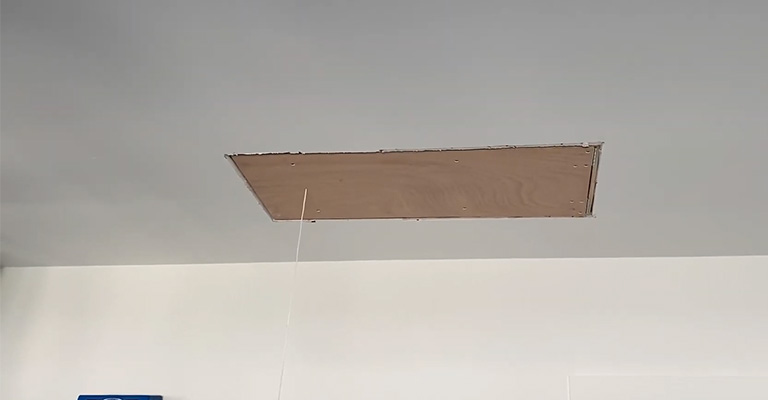
Adding an accent piece to your attic door can be an effective way to hide it if you only need to access your attic a few times per year.
A decorative accent piece adds visual interest to a room by adding furniture, greenery, or plants. An accent piece can hide an attic door by blocking its view.
You can use anything from a tall potted plant to artwork to decorate your home. An accent piece of furniture that doubles as a door blocker could even be commissioned if you have the budget.
5. Install A Scuttle Door Instead Of An Attic Door
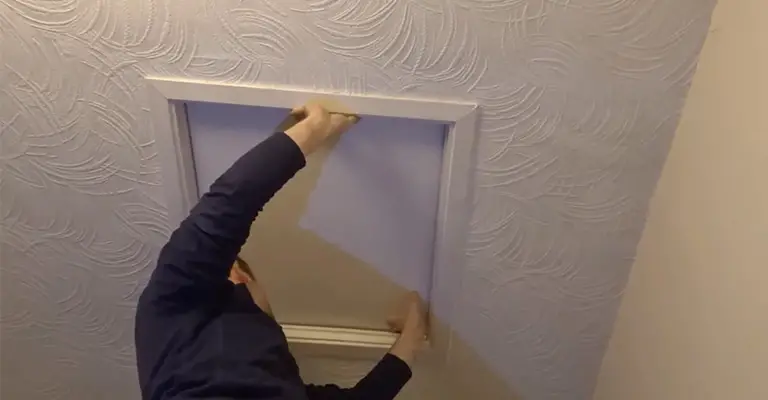
It is common to use attic doors as an entrance to the attic space. Typically, they are located near a staircase or in a hallway. A scuttle door and a traditional attic door are the two main types of attic doors.
The diameter of scuttle doors is half that of traditional attic doors, and they can be installed in closets or other obscure locations.
It is not possible to move traditional attic doors because they are larger. There is a flaw in this technique. The construction code requires that air handlers and other mechanical components be readily serviceable.
In order to accomplish this, you will need a large attic door. It is important to ensure that the air handler or any other equipment won’t be damaged by any attic doors you install.
6. Replace Your Current Attic Doors With Recessed Ones
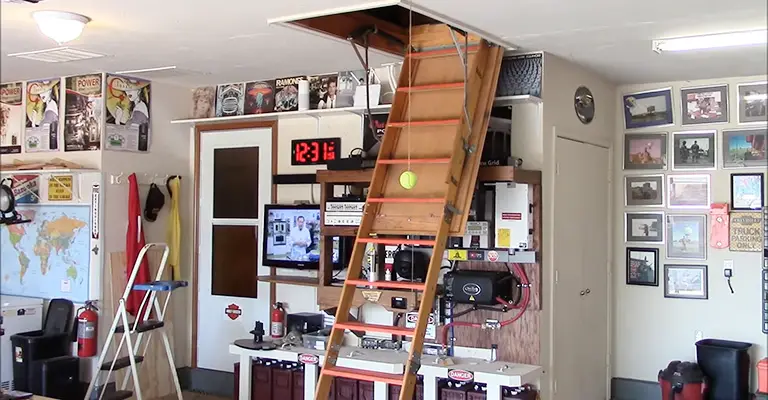
A little bit of extra attention and care is required by all types of attic doors, regardless of their size or shape.
It is crucial that attic doors are in good condition because they are the only access points to the attic.
In recent years, recessed attic doors have become increasingly popular. The flush ceiling design makes them less noticeable than traditional attic doors, as their name suggests.
A pull rope is no longer needed on many recessed attic doors because they have hidden locks and latches.
The only disadvantage of recessed attic doors is that they can be difficult to open in the absence of the right tools.
Unless you’re careful, you might damage the door or its surrounding area. Because of this, your recessed attic door must be handled carefully when opened and closed.
7. Install a Drop Ceiling
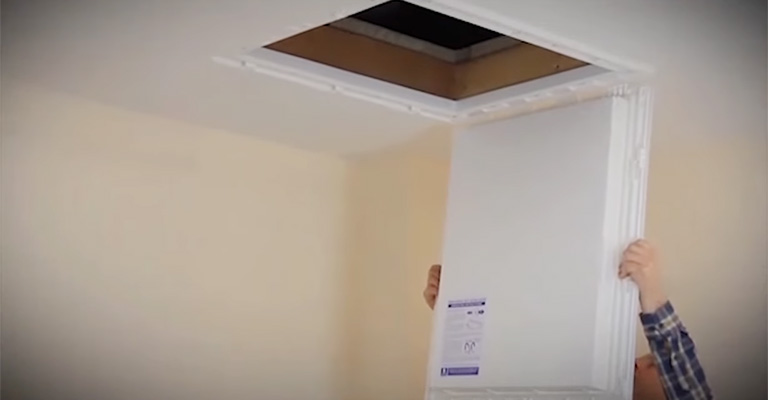
There is usually no problem spotting attic access hatches. They are usually just doors in the ceiling, which can be pretty noticeable if you’re not looking for them.
Drop ceilings, however, allow you to hide the attic access hatch completely. Acoustic ceiling tiles are installed on metal grids to create drop ceilings. No panels need to be cut for attic doors, since they are fixed sizes.
In addition to being easy to install and remove, each drop ceiling tile rests flat on the grid. Electrical and plumbing systems are often hidden above completed ceilings with drop ceilings.
Depending on the drop ceiling height, you may need to modify the door’s height. Drop ceilings can be used to conceal your attic access door, other than that.
8. Construct a Coffered Ceiling
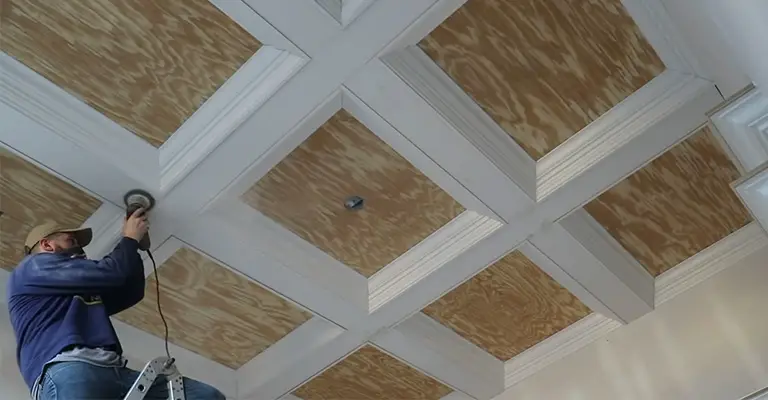
You can hide an attic door with a coffered ceiling. An angled pattern is created by the false ceiling’s panels.
Because the panels are mounted flush with the existing ceiling, it does not reduce the height of the room. The shallowness of this ceiling type also eliminates the need to lower or modify the trusses.
As a result of the shallow depth, an attic ladder can also be installed easily if access to the attic is required. Adding a coffered ceiling to a room can add character and hide attic doors.
9. Make It A Mirror
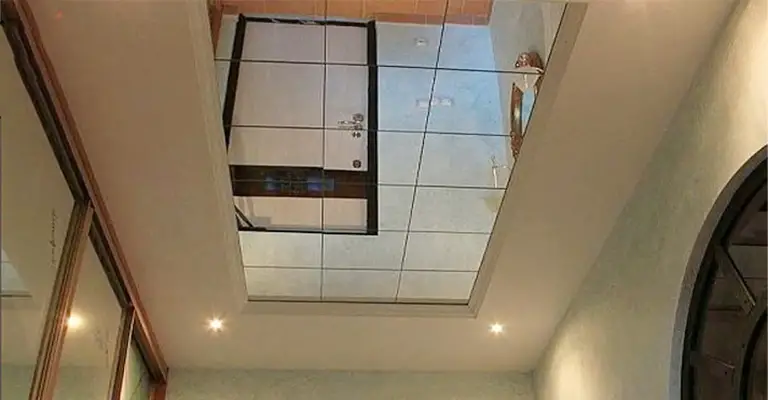
Using this method will give you a polished look, but it is more involved. A mirror with the same size cutout must be made by measuring the door and frame.
Ensure that the door is properly insulated so that there are no drafts coming through.
If there are any gaps around the edges of the mirror after it has been hung, you can use caulk or silicone to seal them. By doing so, your space will appear larger and cleaner, and you will also reflect light.
10. Make A Statement With The In-Ceiling Attic Door
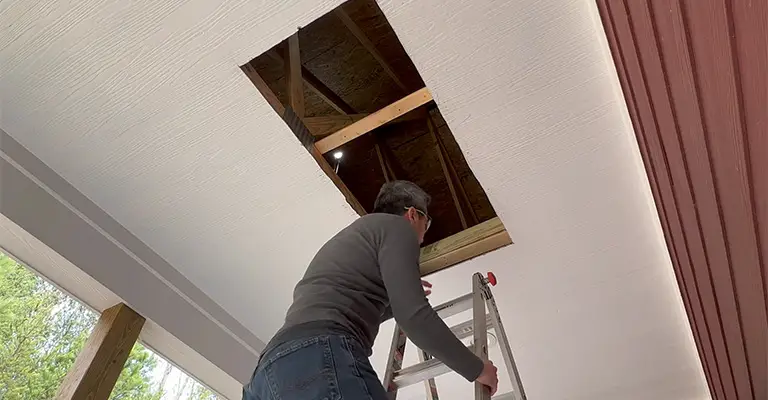
Here are a few ways to highlight your attic entryway. Stained glass windows or paintings can be used to disguise attic doors.
In this case, the artwork is painted on the ceiling in order to make it invisible. Pull cords can be replaced by magnetic push latches in some setups.
An old smoke detector can also be used to conceal a door. A smoke detector is simply a plastic sphere after it has been stripped of its electronics.
During the preparation process, homeowners coiled the pull-down cable inside the bogus smoke detector. When they need attic access, they simply unscrew the unit and release the ladder.
Many people even have removable ceiling panels installed to cover in-ceiling attic ladders. Be sure to hide your attic access well and make it easy to access no matter what approach you choose.
11. Enhance Your Attic Access Door With Visual Patterns And Textures
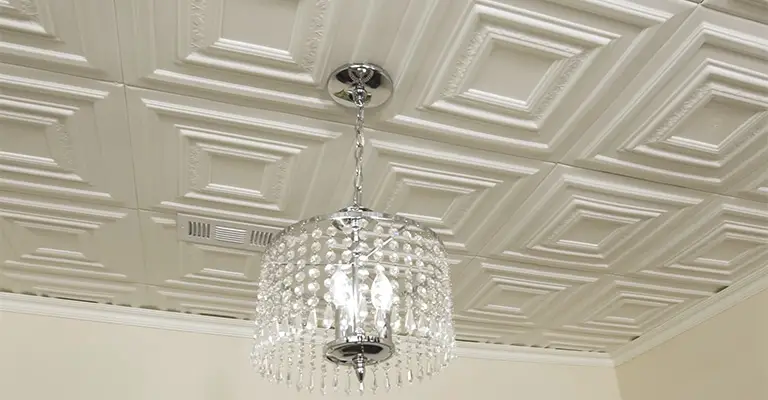
You can hide an attic door by creating a decorative ceiling pattern around the access point. In this case, the attic door will be more noticeable if the ceiling is completely flat and smooth.
At the same height as the entrance, a grid or framework can be placed on the ceiling to achieve texture and pattern.
For example, laying 1 x 3 boards flat could create a grid pattern on the ceiling. If you want to really make your ceiling pop, you can use the same wood to build small box beams around the door frame.
By hiding the attic entrance and adding depth and style to the ceiling, the attic entrance can be concealed.
12. Make Sure Your Curtains Or Drapes Match Your Indoor Furniture
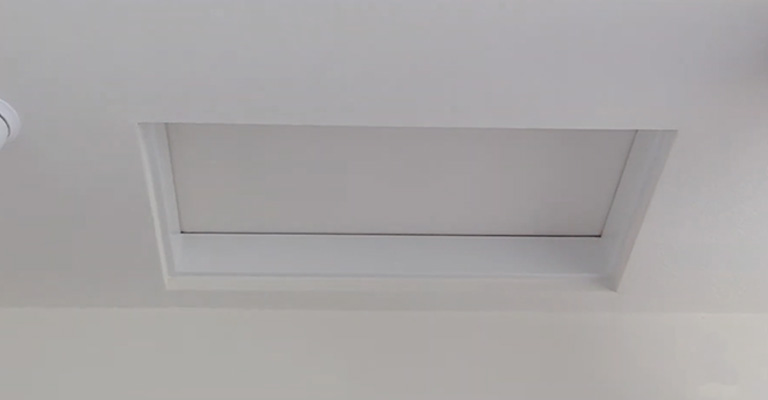
Lastly, you can cover the attic access panel with curtains that match your indoor décor.
By doing this, you will give the space a more finished look and draw the eye away from the door. If you choose curtains or drapes, make sure they are light-colored.
Attic ceiling doors can be camouflaged by hanging curtains or drapes. It is also possible to achieve a pulled-together look by selecting curtains and drapes that complement your interior design.
Attic ceiling doors can be hidden using these simple and effective strategies. Your space will be more attractive and cohesive if you follow one of these suggestions.
Is It Possible To Hide The Attic Door While Still Keeping It Accessible?
There is a possibility of having an attic access entrance hidden from view as well as accessible. This can be achieved by having the door open upwards so that it is not visible from below.
Alternatively, the door can be disguised as something else, such as a bookshelf.
Is My Attic A Scuttle Attic Or An Attic Door?
A standard attic door will have two feet of width and four feet of length as well as a folding ladder mounted on the inside of the door.
Attic doors are commonly found in hallways and open directly into attics. The scuttle door located in the hallway or closet of older homes is often the only way to access the attic.
There is no ladder included with scuttle doors, which are usually two feet by two feet. It is common for scuttle doors to be made from plywood and to be mounted with trim.
How Do I Stop My Attic Door From Drafting?
Installing weatherstripping around the attic door can prevent drafts. Additionally, you can seal off the opening underneath the door with a threshold.
On the bottom of the door, you can also install a door sweep. A heavy curtain can also keep drafts out of the attic.
How Do I Close The Gap In My Attic Door?
In the case of an attic door that leaves a gap in your ceiling, you can do several things to close it. Weatherstripping can be used to create a seal around the door, which will help close the gap.
The installation of a door sweep is another option for creating a seal and closing the gap. Any remaining gaps can be filled with caulk.
Should Attic Access Be Sealed When Hiding?
Rodents, pests, and drafts should be kept out by sealing attic accesses. As well as improving energy efficiency, sealing attic access can prevent moisture damage.
You can seal attic access in various ways, depending on the kind of opening you have. An expanding foam door sweep, weatherstripping, or caulk can be used.
How Do I Cover My Attic Opening?
For an aesthetically pleasing attic opening, there are several ways to cover it. A false ceiling can be added around the opening as an option. By doing this, the opening will appear like a standard ceiling and will be effectively concealed.
In addition, you can install a hinged door in the ceiling to allow access to the attic whenever it is necessary. The attic space can also be accessed by installing a drop-down ladder.
Final Words
It might be a good idea to hide your attic door from casual viewers for a number of reasons. You may want to remove an eyesore or simply eliminate the dangling cord.
It is usually necessary to install an access door between the trusses (or ceiling joists) of an attic, but if you wish to store large items there, it can be enlarged.
An attic door can be hidden in several ways, and which method you choose will depend on your preferences and needs. The good news is that, with a little creativity, you can easily make your attic door virtually invisible.

